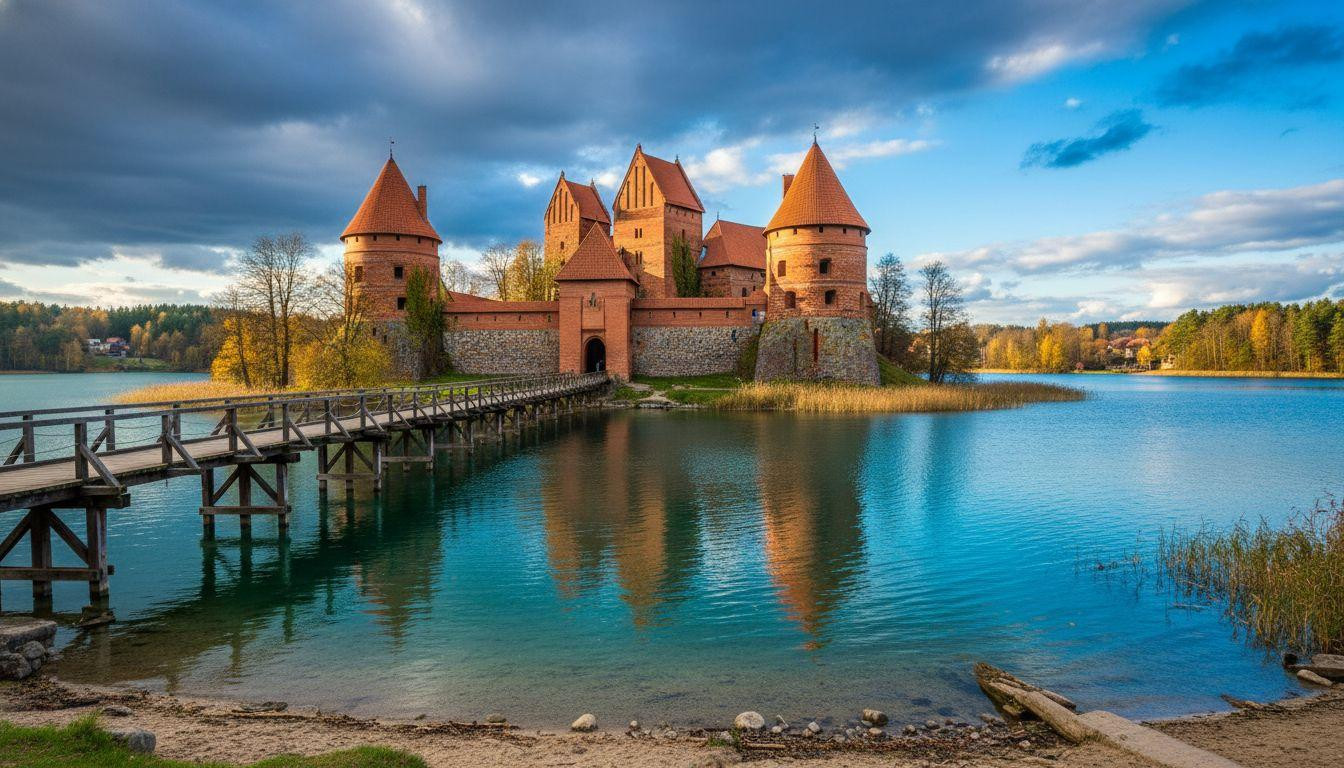Dawn breaks at 7:28 AM over Lake Galvė as November mist transforms red Gothic brick into floating castle. Trakai awakens 17 miles from Vilnius where 4,200 residents guard Lithuania’s island fortress and Europe’s last Karaim community. While millions crush Prague’s bridges and Krakow’s squares, this 14th-century capital-turned-fairytale preserves medieval silence across 200 lakes.
The wooden bridge connects shore to castle island where Vytautas the Great once ruled the Grand Duchy. Now, kibinai pastry steam rises from Karaim bakeries and sunset paints turquoise water gold. This is where Lithuania remembers itself.
Where lake island castle meets living medieval heritage
The 30-minute train from Vilnius costs $1.65-$3.30. First glimpse reveals red brick rising from water. Urban energy vanishes completely.
Trakai Historical National Park surrounds Lake Galvė (361 hectares, 21 islands). Ancient forests frame Lithuania’s deepest waters. The castle occupies the largest island among three original landmasses.
Red brick contrasts turquoise water perfectly. The wooden bridge approaches a fortress begun by Grand Duke Kęstutis in the late 14th century. His son Vytautas the Great completed it around 1409 when this medieval town of 13,000 ruled Central Europe differently.
The revelation: why this island fortress escaped mass tourism
Gothic architecture frozen in amber
Castle walls measure 8.2 feet thick from third construction phase. Three defensive towers anchor corners with southwestern tower doubling as medieval prison. The Ducal Hall spans 33 by 69 feet (only Vilnius Upper Palace surpassed these proportions).
Reconstruction finished in 1961 after 15-year restoration. Museum exhibitions showcase Grand Duchy history across multiple rooms. What makes this visually unique: island location creates Europe’s only walkable water castle.
The Karaim cultural enigma
Vytautas brought Crimean Karaims as guards in 14th century. Turkic-Jewish heritage remains distinct from Lithuanian populations. Wooden houses feature three-window tradition symbolizing community values.
Living families still bake kibinai using ancestral recipes. This isn’t museum-piece heritage. Cultural festivals preserve language and customs while this Greek island offers similar authentic alternatives.
What 30 minutes from Vilnius actually delivers
Castle museum and lake activities
Entry fee runs $7.70-$11. Fortress interior houses Lithuanian medieval exhibitions. Boat rentals cost $11-$27.50 hourly for lake exploration.
Paddling around castle provides perfect photography angles. Summer brings 18-hour daylight and manageable crowds. November 2025 delivers 64°F days with contemplative atmosphere. Winter potentially freezes lake for ice skating.
Karaim quarter and culinary tradition
Kibinai pastries cost $2.20-$3.30 (meat or vegetable-filled specialties). Traditional restaurants serve authentic dishes. Walking wooden-house streets reveals three-window patterns.
Local meals average $7.70-$16.50 versus $22-$44 castle-adjacent dining. Cepelinai (potato dumplings) and cold beetroot soup complement fresh lake fish. Medieval Festival runs July-August with expanded reenactments attracting Baltic heritage seekers.
The November silence Lithuania’s tourists miss
Early morning castle approach reveals mist hovering without tour groups. Sunset from wooden bridge creates perfect castle reflection. Peaceful lakeside picnics at Užutrakis Manor gardens (2.5 miles away) overlook neoclassical estate.
Temporal disconnect strikes visitors: Grand Duchy power once resided here, now preserved in whispers. You experience medieval authenticity at prices 15-25% below Vilnius, 82% below Santorini. Actual residents live heritage versus theme-park reconstruction.
Recent travel press features Trakai as top “under-the-radar” European medieval destination. National Geographic highlights peaceful charm compared to overcrowded sites. Slovak village preservation offers similar wooden architecture authenticity.
Your questions about Trakai answered
How do I get there and what does it cost?
Train from Vilnius: 30-40 minutes, $1.65-$3.30. Car rental: 30 minutes, $22-$33 daily plus fuel. Bus matches train timing and cost.
Accommodation ranges $22-$44 guesthouses, $55-$110 mid-range, $132+ boutique. Total budget: $66-$110 daily comfortable (versus $165+ Western Europe medieval towns). June offers best weather with fewer crowds than July-August peak.
What makes Karaim culture unique?
Turkic-Jewish community distinct from Lithuanian majority. Brought from Crimea 600+ years ago by Vytautas. Three-window houses symbolize community values while kibinai pastries represent signature cuisine.
Language preservation efforts continue with annual cultural festivals. Living heritage blends medieval Lithuanian and Karaim traditions authentically, not museum recreation.
How does this compare to famous medieval towns?
Český Krumlov attracts higher crowds despite similar UNESCO prestige. Hallstatt welcomes 10,000 daily visitors versus Trakai’s manageable 250,000-300,000 annually. Óbidos Portugal draws 1.2 million tourists yearly.
Trakai offers authenticity plus affordability plus resident community plus island castle drama. No suffocating crowds, 82% cost savings versus Santorini pricing.
As November light fades at 4:30 PM, castle walls glow amber against darkening water. A Karaim grandmother lights candles in her three-windowed house. Tomorrow, 4,200 residents will wake to another day guarding Lithuania’s island heart.
